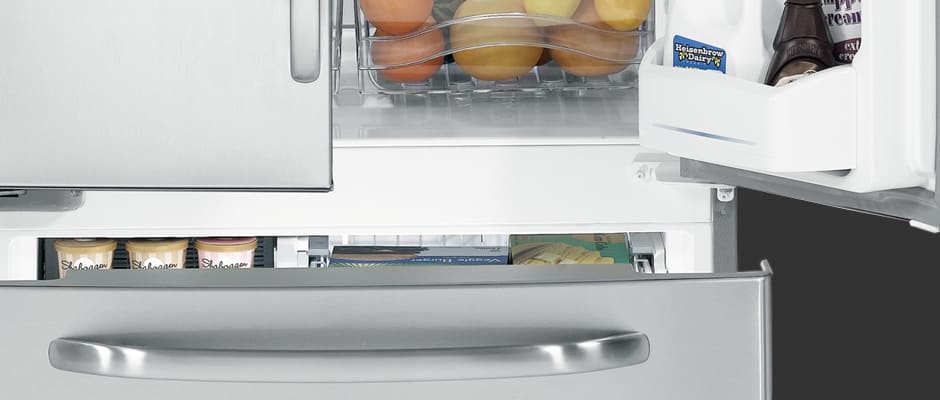Pros
Cons
Introduction
Temperatures in both the freezer and the fridge were consistent, the vegetable drawers retained plenty of moisture, and energy consumption was reasonable as well. With an MSRP of $1,699, we were hoping to get some extra features, though.
Design & Usability
{{section_header}}{{section.name}}{{/section_header}}
Stately and staid, the GE GFSS2HCYSS is a classic French door design.
The GE GFSS2HCYSS is a French door refrigerator with a bit of curvature toward the top of the doors and a stainless steel finish with a horizontal grain. As with most stainless steel models, fingerprints show up quite easily—keep this in mind if you have children. Open the french doors and you will find a rather basic interior. Some shelves are adjustable, allowing for a bit of customization, but there is nothing revolutionary going on. An ice maker takes up about a third of the top freezer drawer, limiting that space considerably.
As for controls, these are located on a panel at the top of the refrigerator compartment. Annoyingly, these touch controls do not list actual temperatures, but rather ambiguous numbers on a scale that make conditions cooler or warmer. Users can select the number 4, but if they want to know the actual temperature, they'll have to buy a thermometer.
{{photo_gallery "Front Photo", "Fingerprints Photo", "Handle Photo", "Handle Detail Photo", "Water/Ice Dispenser Photo", "Water/Ice Dispenser Controls Photo", "Water/Ice Dispenser Detail Photo", "Interior Photo", "Refrigerator Main 1 Image", "Refrigerator Main 2 Image", "Refrigerator Main 3 Image", "Water Filter Photo", "Refrigerator Door 1-1 Image", "Refrigerator Door 1-2 Image", "Refrigerator Door 1-3 Image", "Refrigerator Door 2-1 Image", "Refrigerator Door 2-2 Image", "Refrigerator Door 2-3 Image", "Freezer Main 1 Image", "Freezer Main 2 Image", "Freezer Main 3 Image", "Freezer Door 1 Image", "Freezer Door 2 Image", "Freezer Door 3 Image", "Ice Maker Photo", "Back Photo", "Back Detail Photo", "Sides Photo", "Side Detail 1 Photo", "Side Detail 2 Photo", "Fridge Temperature Image", "Freezer Temperature Image", "Vegetable Drawer Photo", "Vegetable Drawer Controls Photo", "Ease of Access Photo", "Controls Photo", "Cleaning Photo", "Other Features Photo"}}
Features
{{section_header}}{{section.name}}{{/section_header}}
Shelves hard to adjust, drawers flimsy, features scarce.
Drawers slide with marked hesitation and heavy glass shelves are rather difficult to reposition since they must hook into slats mounted on the back of the fridge. Gaps between the glass shelves and their frames mean that interior spills can dribble down to food stored below. Additionally, some users may experience difficulty bending down to use the freezer, especially since items must be piled on top of each other.
The fridge and freezer have separate temperature controls mounted on the interior light fixture at the top of the fridge, and as we mentioned before, they do not display actual temperatures. Instead, these thermostats offer single digit numerical displays.
Performance
{{section_header}}{{section.name}}{{/section_header}}
From temperature to humidity testing, the GE GFSS2HCYSS did well through all of our trials.
The top shelves of the refrigerator compartment in the GE GFSS2HCYSS were warmer than the bottom shelves. That points to inadequate airflow and the descent of cold air to the bottom of the fridge cavity. That gallon of milk may spoil more quickly on the top shelf. Despite differing shelf readings, temperatures didn't vary much over time. Consistency like this is good for preserving food.
As for the freezer, since the ice maker and the vents are at the top, food packages in the top drawer were slightly cooler than those on the bottom drawer. Still, the internal temperatures of each food package stayed consistent, which indicates that the GE GFSS2HCYSS does a fine job protecting against the slight thawing and refreezing that leads to freezer burn.
On a final note, assuming that electricity sells for $0.09 per kW-h, the GE GFSS2HCYSS would cost you $43.52 a year to run. That’s low, especially comparatively speaking.
Conclusion
{{section_header}}{{section.name}}{{/section_header}}
It's light on features, but this French door is an adept machine.
The GE GFSS2HCYSS is a solid fridge with solid temperature performance, great moisture retention, and excellent energy efficiency. On the other hand, it was definitely difficult to move the heavy shelves around inside this fridge, and spill protection was lacking too. For the asking price of $1,699, we would have liked to see some more features, like a water/ice dispenser.
Overall, though, since the GE GFSS2HCYSS is readily available online for at least a couple hundred dollars less than the MSRP, it's a solid recommendation to those who absolutely must have a French door fridge.
Science Introduction
{{section_header}}{{section.name}}{{/section_header}}
Though the fridge and freezer both have certain shelves that are warmer or cooler than the overall temperature, food stored in the GE GFSS2HCYSS nevertheless maintaines a consistent temperature, and veggies in the vegetable drawer don’t dry out. Energy efficiency was also above-average.
Temperature Performance
{{section_header}}{{section.name}}{{/section_header}}
Temperatures vary a bit based on location, but at least they are consistent over time.
The top shelves of the refrigerator compartment in the GE GFSS2HCYSS were on average about 4 degrees warmer than the bottom shelves. That points to inadequate airflow and cold air that falls to the bottom of the fridge cavity. Despite the variance based on location, the internal temperatures of individual food packages remained very consistent, rarely varying more than half a degree.
As the ice maker and vents are at the top of the freezer compartment, food packages in the top drawer were about a degree colder than those in the bottom drawer. Still, the internal temperatures of each food package stayed consistent—this GE does a fine job protecting against the slight thawing and refreezing that leads to freezer burn.
{{photo_gallery "Science Section 1 Images"}}
Moisture Retention
{{section_header}}{{section.name}}{{/section_header}}
Moisture loss is kept to a bare minimum.
Veggies won’t dry out in the GE GFSS2HCYSS. Our simulated test veggie went into the vegetable drawer and lost a mere 0.11 grams of water per hour. That’s far better than average for the fridges we’ve tested.
{{photo_gallery "Science Section 2 Images"}}
Freezing & Thawing
{{section_header}}{{section.name}}{{/section_header}}
Freezing room temperature items takes too long.
The benefit of “flash freezing” food is that ice crystals don’t form. When food thaws, those crystals change the texture of the food. Unfortunately, no consumer-grade freezer can flash freeze foods yet, least of all this GE. At 2 hours and 3 minutes, the GFSS2HCYSS took a little longer that we’d prefer.
When you lose power, you’ll want the food in your freezer to stay cold. This model has no problem with that. 36 hours after we pulled the plug, the internal temperature of the food inside the GE’s freezer hadn’t yet thawed, which is an excellent result.
{{photo_gallery "Science Section 3 Images"}}
Storage Space
{{section_header}}{{section.name}}{{/section_header}}
With a small freezer compartment and less usable space than side-by-side or top freezers, this isn't the best choice frozen pizza fans.
With four adjustable shelves, one storage drawer, and two crisper drawers, the GE GFSS2HCYSS offers 10.34 cubic feet of storage space. That’s less than what the manufacturer states, but we only measure actual usable space, with acknowledgment of shelves and vents and light fixtures.
The freezer is made up of two drawers, one which nests inside the other. Together, they offer 3.05 cubic feet of storage space.
In addition to the total energy use, we look at energy consumption as a function of how much space the fridge has, since using a little more energy might be worth it if you’re cooling a lot more food. The GE GFSS2HCYSS chills a single cubic foot with 0.11 kW-h of electricity, which is about average among all fridges, big and small.
{{photo_gallery "Science Section 4 Images"}}
Other Tests
{{section_header}}{{section.name}}{{/section_header}}
{{photo_gallery "Other Tests Images"}}
Meet the tester
Keith was the Editor in Chief of Reviewed's appliance and automotive sites. His work has appeared in publications such as Wired, Car & Driver, and CityLab.
Checking our work.
Our team is here to help you buy the best stuff and love what you own. Our writers, editors, and experts obsess over the products we cover to make sure you're confident and satisfied. Have a different opinion about something we recommend? Email us and we'll compare notes.
Shoot us an email

